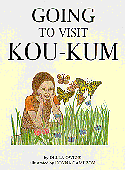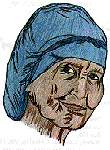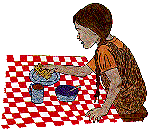


|
Going to Visit Kou-Kum.
Della Owens. Illustrated by Donna Cameron. Subject Headings:
Kindergarten - grade 3 / Ages 5 - 8. **1/2 /4
|

excerpt:
"Many years ago, when Tanis was eight, she set out on a special visit to Kou-Kum. It was the first time she was allowed to go along. She was the youngest of the family.She had eight brothers, one sister, a mother and a father, so there had always been someone to go with her. Tanis was excited, but at the same time, scared to go.
This was a very special visit, so Tanis was wearing her Sunday clothes. She even had clean running shoes because her mother had washed them."
 Going to Visit Kou-Kum is a story about a young native girl (Tanis) who is off to visit her grandmother. It is the first time she has walked down the road by herself. As the youngest of a large family, she was normally accompanied by an older sibling. Along the way she encounters a frog and a coyote, and must overcome her fears to go past them and get to Kou-Kum's house, where she finds safety, warmth, and teaching. She draws strength from her grandmother, and the courage to skip home with a smile on her face, able to face her fears.
Going to Visit Kou-Kum is a story about a young native girl (Tanis) who is off to visit her grandmother. It is the first time she has walked down the road by herself. As the youngest of a large family, she was normally accompanied by an older sibling. Along the way she encounters a frog and a coyote, and must overcome her fears to go past them and get to Kou-Kum's house, where she finds safety, warmth, and teaching. She draws strength from her grandmother, and the courage to skip home with a smile on her face, able to face her fears.
This is a warm family story, about the bond between grandmother and grandchild. It has special application to aboriginal families where the grandparents traditionally play a major role in educating the children about native traditions. The story reinforces the tradition of the guiding role of the grandparent. It is the author's first book, and has been published to "preserve and promote stories of cultural interest to members of this community." (back cover). It is also suggestive of Red Riding Hood, who, like Tanis, dawdles on the road to her grandmother's house.

The writing could use more polishing, and it is hoped that future work by Della Owens and editing by Twin Sisters Publishing will produce more refined stories.
For example, Tanis is frightened by the frog, but the reader is not informed what happens to the frog as Tanis passes. The coyote is shown slinking into the woods, but again, the reader is not told that the coyote leaves, or why. Tanis's apprehensions are not fully explored; she seems to be going from one event to another. Her visit to her grandmother's house is also like one event following another, and the important lesson that Kou-Kum teaches, about respecting animals could be developed further.
The illustrations are carefully drawn coloured pencil drawings, and each page of text is framed by sparse branches of leaves. A glossary at the front of the book defines Cree words used in the story, and a bannock recipe is included at the back of the book, along with the author's recommendation on how she enjoys it.
Going to Visit Kou-Kum will be useful as a story book, and as a thematic link to studying fears, family, grandparents, community, and aboriginal families and tradititions.
Recommended with reservations.
Harriet Zaidman is a teacher-librarian in Winnipeg.

To comment on this title or this review, send mail to cm@umanitoba.ca.
Copyright © 1996 the Manitoba Library Association. Reproduction for personal use is permitted only if this copyright notice is maintained. Any other reproduction is prohibited without permission.
Published by
The Manitoba Library Association
ISSN 1201-9364
AUTHORS |
TITLES |
MEDIA REVIEWS
BACK ISSUES |
SEARCH |
HOME